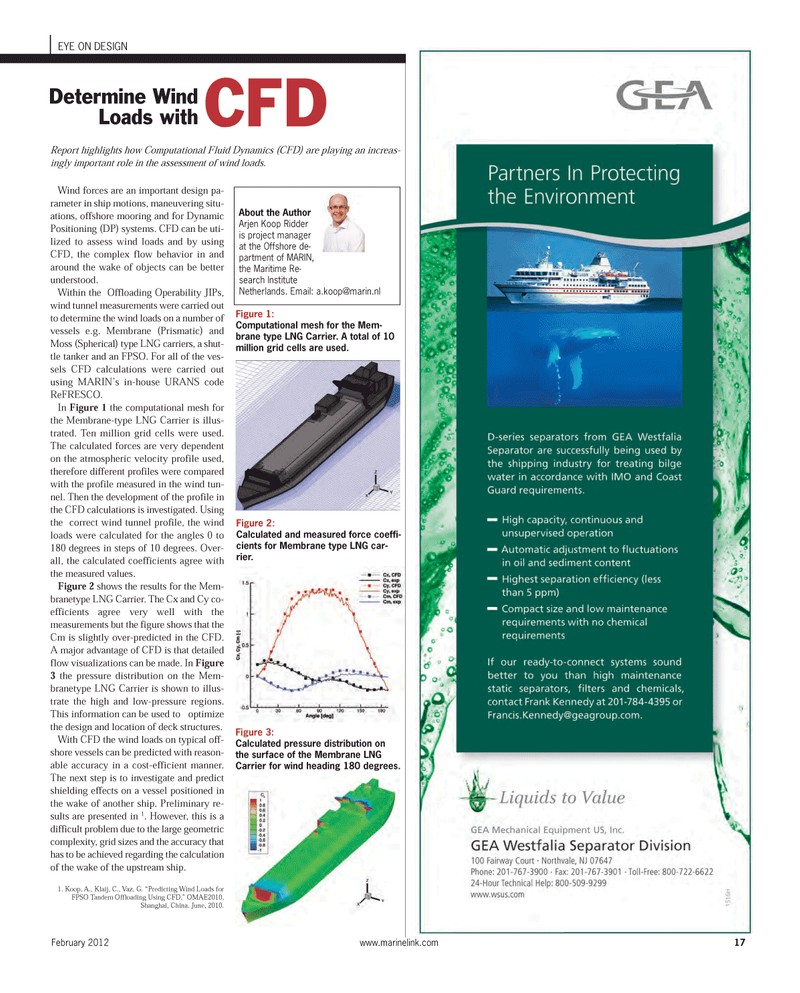
Page 17: of Maritime Reporter Magazine (February 2012)
Cruise Shipping Annual
Read this page in Pdf, Flash or Html5 edition of February 2012 Maritime Reporter Magazine
EYE ON DESIGNFebruary 2012www.marinelink.com 17Wind forces are an important design pa- rameter in ship motions, maneuvering situ- ations, offshore mooring and for Dynamic Positioning (DP) systems. CFD can be uti-lized to assess wind loads and by usingCFD, the complex flow behavior in and around the wake of objects can be better understood. Within the Offloading Operability JIPs, wind tunnel measurements were carried outto determine the wind loads on a number ofvessels e.g. Membrane (Prismatic) and Moss (Spherical) type LNG carriers, a shut-tle tanker and an FPSO. For all of the ves- sels CFD calculations were carried outusing MARIN?s in-house URANS code ReFRESCO. In Figure 1 the computational mesh forthe Membrane-type LNG Carrier is illus-trated. Ten million grid cells were used. The calculated forces are very dependent on the atmospheric velocity profile used, therefore different profiles were compared with the profile measured in the wind tun- nel. Then the development of the profile in the CFD calculations is investigated. Using the correct wind tunnel profile, the wind loads were calculated for the angles 0 to180 degrees in steps of 10 degrees. Over- all, the calculated coefficients agree with the measured values. Figure 2 shows the results for the Mem- branetype LNG Carrier. The Cx and Cy co- efficients agree very well with the measurements but the figure shows that the Cm is slightly over-predicted in the CFD. A major advantage of CFD is that detailed flow visualizations can be made. In Figure 3the pressure distribution on the Mem- branetype LNG Carrier is shown to illus- trate the high and low-pressure regions. This information can be used to optimizethe design and location of deck structures. With CFD the wind loads on typical off- shore vessels can be predicted with reason- able accuracy in a cost-efficient manner. The next step is to investigate and predict shielding effects on a vessel positioned in the wake of another ship. Preliminary re- sults are presented in 1. However, this is a difficult problem due to the large geometric complexity, grid sizes and the accuracy that has to be achieved regarding the calculation of the wake of the upstream ship. 1. Koop, A., Klaij, C., Vaz, G. ?Predicting Wind Loads for FPSO Tandem Offloading Using CFD,? OMAE2010, Shanghai, China. June, 2010.CFDAbout the AuthorArjen Koop Ridderis project manager at the Offshore de- partment of MARIN, the Maritime Re-search Institute Netherlands. Email: [email protected] 3: Calculated pressure distribution on the surface of the Membrane LNG Carrier for wind heading 180 degrees. Figure 2: Calculated and measured force coeffi- cients for Membrane type LNG car- rier. Figure 1: Computational mesh for the Mem-brane type LNG Carrier. A total of 10 million grid cells are used. Report highlights how Computational Fluid Dynamics (CFD) are playing an increas- ingly important role in the assessment of wind loads. Determine Wind Loads with MR Feb.12 # 2 (10-17):MR Template 2/6/2012 9:30 PM Page 17

 16
16

 18
18
